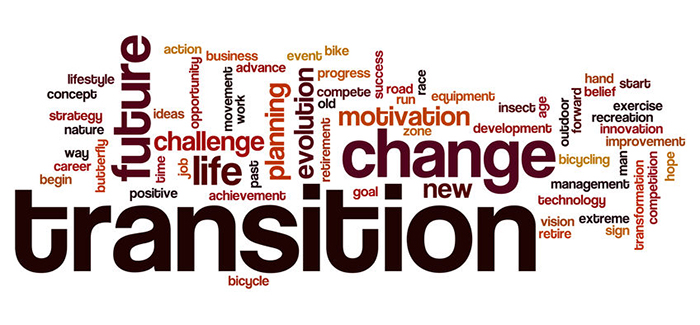 Life transitions — those voluntary or involuntary changes we make, personally or as a community, is the basis of the book “Life is in the Transitions – Mastering the Change at Any Age.”
Life transitions — those voluntary or involuntary changes we make, personally or as a community, is the basis of the book “Life is in the Transitions – Mastering the Change at Any Age.”
Some of you know the work of Bruce Feiler, a New York Times best-selling author, who made his mark with a book called “Council of Dads.” (It later became a highly respected television program.) Bruce was diagnosed with a serious, potentially terminal, illness. He assumed he was not going to see his twin girls grow up. He gathered six key men in his life and asked them to form a group that would guide his children into the future. It was a brave, insightful, and creative project embraced by many worldwide. FYI — he survived and thrived.
His recent work is to spread a wider net. Over a five-year period, he spoke with hundreds of people about their lives, their struggles, and significant triumphs. Then, accumulating that data, looked for similarities, frequency, and applicability. These weren’t traditional interview questions. He asked interviewees to tell their life stories. He harvested their transitions’ information, finding definable traits useful to many.
His first insight was to acknowledge our lives are no longer linear. We don’t measure time by the sunrise and set or the seasons as our ancient ancestors did. Nor do we necessarily subscribe to many of the stages of life formulas a variety of social scientists insisted existed. (Remember the stages of grief?) The idea you are born, go to school, get married, stay in a job, retire, and then get old and die no longer is true for many people. We do things out of the formerly prescribed order — starting-up new companies in our 20s, birthing children in our 40s, changing careers in our 60s. How we make these moves are what Feiler calls life transitions.
The research revealed transitions can be voluntary (change careers, choose to move to a very different location,) or involuntary (loss of job, health crisis) and also can be either personal (divorce or returning to school), or impacting many members of the community (as the current pandemic does or natural disasters will). How we cope with such changes is our life transitions process.
Data showed we have “disruptions” in our lives every 12-18 months. Don’t agree? Think about it. New boss, changed departments, working remotely, moved; had an annoying, but not serious, health issue, the stock market ups and downs, you gave birth, a loved one died? You get the picture. Most were unpredictable, many are for the better, some seem terrible but end up enhancing our lives, and others are real challenges.
Then there are times when something dramatic, even catastrophic, occurs. Feiler calls these lifequakes and they can happen to just you, your family, your neighbors, or the world. According to Feiler’s data, eighty-seven percent involve leaving or rejecting a stable condition, striving for personal fulfillment. Who hasn’t been impacted by the virus? The real question is how are you handling it? What life transitions have you decided to make or have been forced upon you? What growth and satisfaction will come from it?
Feiler recognized some common behaviors in his life transitioninginterviewees. One of them, because there is not necessarily an order to their occurrence, is what he calls “the long goodbye.” It is where you admit and accept things have changed and work to adapt and accept. Data shows this is the hardest for most people. It is not only saying farewell to people but maybe to status, control, a way of operating, and/or interaction.
Another part of the goodbye life transition process is emotions (all of them). More interviewees reported fear as their strongest feeling, though sadness and shame also ranked high. How they dealt with them ranged from journaling to getting absorbed in a project, but “eight in ten turned to rituals” — they did things specifically involving transition. Tattoo anyone? How about an ashram? Salsa classes? Finishing the crossword puzzle daily? Skydiving? Reigniting old loves or connections?
In the “goodbye” is also the need to cleanse, shed. That means ridding yourself of “your mindset, routines, delusions and outdated dreams” and making room for the new. Is it files on your laptop, photos of your ex, no longer introducing yourself with your job title, changing your entire lifestyle? These can be replaced with a popular interviewee solution — creativity. Many either started or returned to creative actions. “At moments of greatest chaos, they responded with creation” according to Feiler. Remarkable.
Life transitions help us rewrite or update our stories. Not sure what yours is? Here is some encouragement to take a stab at it. Transition interviewees, when asked about their life themes, frequently mentioned struggle, self-actualization, service, gratitude, and love as topics that came to light. Those could get you started.
Keep in mind life transitions are non-linear. You cannot always predict when and where. Many more people are making these kinds of transitions than ever before. They want or have been forced to. You are one of many millions impacted by the pandemic. What story do you want to take out of it?
Life transitions take time and probably will be longer than you want. You need the hours and days. Be the key character in your story. All narrative should revolve around you. You are writing your autobiography. Write an honest one.
Transitions prevent you from being and feeling stuck. They offer options and alternatives. There is the opportunity to make a difference in the near and far. They could change your life. Pretty powerful, yes?
Leave a Reply